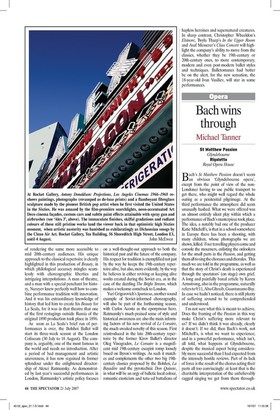Summer treats
Giannandrea Poesio rr he summer ballet season in London, with the traditional arrival of illustrious foreign guests, has a well-established historical tradition. It was during the summer months that, in the 19th century, famous and not-so-famous foreign ballet stars appeared on the stages of theatres such as the Her Majesty's, the Alhambra and the Empire Later on, renowned ballerinas such as Lydia Kyasht, Olga Preobrajenska and the legendary Anna Pavlova came to London in summer with small companies or groups, leading the way for Diaghilev's Ballets Russes, the quintessential 'visiting' ballet company of the first half of the past century. Since then, the summer ballet season in London has provided dance goers with a wealth of memorable experiences. This year is no exception, for there are some delectable treats in store.
The season kicks off next week, at the Royal Opera House, with the classic The Sleeping Beauty, performed by the ballet company from La Scala Theatre (25-29 July). Considered by many as the Italian temple of opera and dance, La Scala has played a significant role in the history of ballet and also, more or less directly, in the history of British ballet. Many of the admired stars who appeared at the Empire and the Alhambra had either trained or performed regularly at La Scala. Their performances had such an impact on the London dance scene that many indigenous dancers had to change their names into Italiansounding ones, to get some sort of artistic credibility.
Moreover, former La Scala celebrities, such as Francesca Zanfretta and Malvina Cavallazzi, settled in the English capital, where they subsequently taught the first generation of home-grown 20th-century British dancers, thus contributing to the development of British 20th-century ballet. Not to mention the fact that it was for La Scala that choreographers such as Frederick Ashton and John Cranko created some of their most memorable works.
Indeed, to come to London with The Sleeping Beauty is a daring move, given that the ballet in question is integral to the history of ballet in this country. Yet, this is no ordinary Sleeping Beauty but the one staged by Rudolf Nureyev for the Italian ballet company in 1967. As such, it belongs to that number of ballet revisitations Nureyev created in order to pursue a very personal campaign of popularisation of the classical repertoire immediately after his defection from Soviet Russia. In each case, he achieved his objective by proposing subjective readings of the old works, in the hope of rendering the same more accessible to mid 20th-century audiences. His unique approach to the classical repertoire is clearly highlighted in this production of Beauty, in which philological accuracy mingles seamlessly with choreographic liberties and intriguing interpolations. A man of theatre, and a man with a special penchant for history, Nureyev knew perfectly well how to combine performance tradition with innovation. And it was his extraordinary knowledge of history that led him to create his Beauty for La Scala, for it was in that theatre that one of the first restagings outside Russia of the original 1890 production took place in 1896.
As soon as La Scala's brief run of performances is over, the Bolshoi Ballet will start its three-week season at the London Coliseum (30 July to 18 August). The company is, arguably, one of the most famous in the world and needs no introduction. After a period of bad management and artistic unevenness, it has now regained its former splendour under the enlightened directorship of Alexei Ratmansky. As demonstrated by last year's successful performances in London, Ratmansky's artistic policy focuses on a well-thought-out approach to both the historical past and the future of the company. His respect for tradition is exemplified not just by the way he keeps the 19th-century repertoire alive, but also, more evidently, by the way he believes in either reviving or keeping alive works created during the Soviet era, as in the case of the dazzling The Bright Stream, which makes a welcome comeback to London.
Yuri Grigorovich's Spartacus, another sound example of Soviet-informed choreography, will also be part of the forthcoming season, with Carlos Acosta as the eponymous hero. Ratmansky's much-praised sense of style and historical awareness are also the main informing factors of his new revival of Le Corsaire, the much-awaited novelty of this season. First reintroduced in the late 20th-century repertoire by the former Kirov Ballet's director Oleg Vinogradov, Le Corsaire is a magnificent mid 19th-century escapist romp loosely based on Byron's writings. As such it matches and complements the other two big 19thcentury classics proposed by the Bolshoi, La Bayadere and the pyrotechnic Don Quixote, in what will be an orgy of balletic local colour, romantic exoticism and tutu-ed battalions of hapless heroines and supernatural creatures. In sharp contrast, Christopher Wheeldon's Elsinore, Twyla Tharp's In the Upper Room and Asaf Messerer's Class Concert will highlight the company's ability to move from the classics, whether they be 19th-century or 20th-century ones, to more contemporary, modern and even post-modern ballet styles and techniques. Balletomanes had better be on the alert, for the new sensation, the 18-year-old Ivan Vasiliev, will star in some performances.













































 Previous page
Previous page